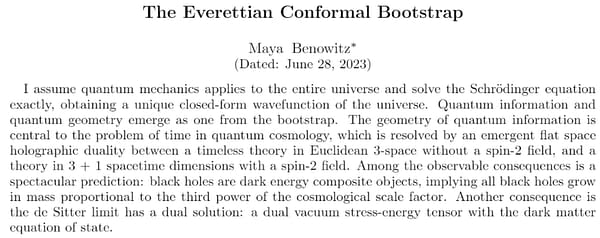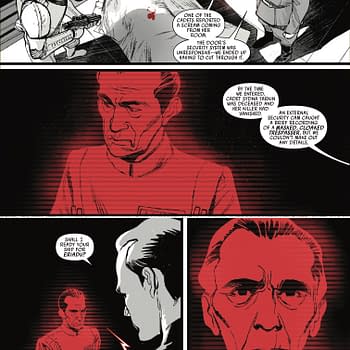Posted in: Comics | Tagged: Maya Benowitz, Multiverse
Maya Benowitz Proves the Multiverse, Asks Where Time Travellers Are?
This morning, Maya Benowitz posted a scientific paper that proved the multiverse and explained black holes. Why what did you do this morning?
This morning, mathematical physicist and quantum cosmologist Maya Benowitz posted a scientific paper to Twitter that a) proved the multiverse b) explained black holes and c) asked where all parallel universe time travellers were? Not bad for a Wednesday. After all her Twitter bio also claims she is an " Aspiring Time Lord & Tardis engineer," Well, she may have suddenly come a lot closer than the rest of us. My dad is a Physics teacher, so I've just sent him a copy, but I know our mutual love for Robert Heinlein's By His Bootstraps story in which everyone in it is the same single time traveller, will have piqued his curiosity. Just as long as it's not The Endochronic Properties of Resublimated Thiotimoline.
The paper is titled "The Everettian Conformal Bootstrap" referring to Hugh Everett III, the physicist behind the many-worlds interpretation of quantum physics, and she states "I assume quantum mechanics applies to the entire universe and solve the Schrödinger equation exactly, obtaining a unique closed-form wavefunction of the universe. Quantum information and quantum geometry emerge as one from the bootstrap." and she makes the prediction that "black holes are dark energy composite objects, implying all black holes grow in mass proportional to the third power of the cosmological scale factor."

Basically the universe created itself, the multiverse is real, and can be proved through experiments and "there must exist worlds where future humans master the quantum nature of spacetime and travel to "past-adjacent" light cones — a form of time travel in the multiverse. But if this were possible, then where are they?"
Clearly, they are everywhere, all at once. Because multiverse storytelling has been around ages, however you want to describe it. Stories of other realities are as old as heaven and hell, fairyland and more. "What If" histories were not uncommon, the earliest recorded being Livy's Ab Urbe Condita Libri with an alternative 4th century BC in which Alexander the Great had survived to attack Europe had planned, only to be defeated by the Roman Empire.

Joanot Martorell's romance from 1490 AD, Tirant lo Blanch, us a wish fulfilment fantasy after the Christian army's loss of Constantinople to the Turks, in which Tirant the White stops that from ever happening. Louis Geoffroy's History of the Universal Monarchy: Napoleon and the Conquest of the World from 1836, tells the story of Napoleon's successful invasion of Russia and then England. A scenario that Bryan Talbot would also use in Grandville, P.'s Correspondence, by Nathaniel Hawthorne from 1845, is a memoir in which famous folk didn't die but continued to live on, while Aristopia by Castello Holford from 1895 saw early settlers in Virginia discover mountains made of gold, and use that to develop a very different society.
The concept blossomed in the twentieth century, with H. G. Wells' A Modern Utopiain in 1905 which explicitly was science fiction, stating that the narrator is someone who jumped to our world from another world at a specific point in time and space for history to play out differently, before returning to our timeline. Such historical What Ifs became a publishing industry in and of themselves and became rather respectable, with Joseph Edgar Chamberlin's The Ifs of History from 1907 and Charles Petrie's If: A Jacobite Fantasy from 1926 as prime examples. These were parlour pieces, seen as thought experiments but also attempts to show the strategic and logical abilities of the writer, as well as some wish fulfilment and settling of scores. Sir John Squire collected a series of essays from leading historians and thinkers such as Hilaire Belloc, André Maurois, and a yet-to-be Prime Minister Winston Churchill for 1931's If It Had Happened Otherwise, asking "If the Moors in Spain Had Won" and "If Louis XVI Had Had an Atom of Firmness" including Hendrik Willem van Loon's portrayal of New Amsterdam, a Dutch city-state on the island of Manhattan. Decades later, New Amsterdam was picked up by Mark Gruenwald for his own multiverse stories in Marvel Two-In-One when setting rules for such travel. Winston Churchill's entry "If Lee Had Not Won the Battle of Gettysburg" was even more fanciful, written from the perspective of someone living in a world in which the South had won the US Civil War, writing a piece of fiction about what if the North had won and getting it wrong.

H.G. Wells' Men Like Gods from 1923 was the first however to show a multiverse of alternative histories and a way to travel between them all, even if travel only occurs to one of them. But as the What If histories collided with pulp science fiction, stories of parallel universes, and creating them by time travel, grew. Much of this was a result of Everett and later Edwin Schrödinger who posited the concept of the idea of simultaneous histories occurring alongside each other with quantum experiments and theories, cat included. Suddenly there was a scientific explanation for sci-fi writers to seize upon.
And in 1961 with The Flash Of Two Worlds, by Gardner Fox and Carmine Infantino, we had the origin of the DC Multiverse and the word "multiverse" used in this concept for the first time, with Earth One and Earth Two versions of Superman, Batman and their surrounding cast. It was Michael Moorcock who started to play more with the concept of the multiverse in 1963 with The Sundered Worlds, part of his Eternal Champions series of prose stories which posited the same character playing out in very different realities, and meeting other versions of themselves. Bryan Talbot would also pick this up with his seventies comic book series Luther Arkwright, numbering each reality into the millions.
But it was David Thorpe, Alan Moore and Alan Davis in the Captain Britain comic books, influenced by Talbot, that created something that would become a trope of its own, meeting many versions of your parallel selves, creating an Army Of One or a council of just yourself. Captain Britain met the many other members of the Captain Britain Corps, each from a different universe. This was itself a take on the Green Lantern Corps made up of different alien races, the Captain Britain Corps was made up of parallel realities – the Marvel Comics one being 616. Something taken very seriously by Jonathan Hickman with his Council Of Reed Richards. And it was that, which informed Dan Slott for the Spider-Verse, Scott Snyder for the Dark Multiverse Batmen and the Council Of Ricks in Rick And Morty. Jeff Loveness was a writer on Rick And Morty whose fondness for Alan Moore stories can be seen in the Black Mercy comic he wrote and also wrote Ant-Man And The Wasp: Quantumania.
Now multiverse films like Everything Everywhere All At Once win Oscars. Art and science and frogmarching side by side, where one leads, the other appears to play catch up.













